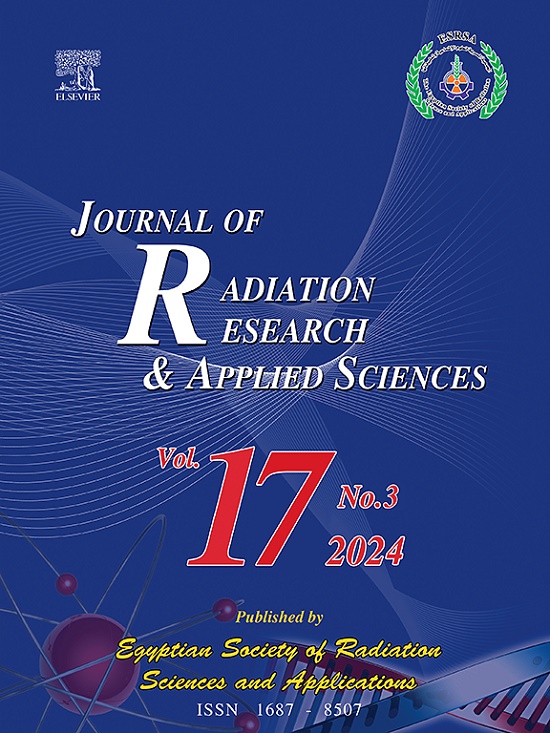Influence of thermal radiation on ternary hybrid nanofluid with thermal non-equilibrium effects and activation energy: Implications for biomedical applications
IF 1.7
4区 综合性期刊
Q2 MULTIDISCIPLINARY SCIENCES
Journal of Radiation Research and Applied Sciences
Pub Date : 2025-05-21
DOI:10.1016/j.jrras.2025.101627
引用次数: 0
Abstract
In this paper, the effects of thermal radiation on the trihybrid nanofluid with local thermal non-equilibrium effects within a stenotic artery are briefly discussed. This article discusses the importance of activation energy and convective conditions. In the current study, the features of heat transmission without LTECs (local thermal equilibrium conditions) are investigated using a simple mathematical model. Two distinct necessary thermal gradients are produced for both the solid and liquid phases using the LTNE conventional approach. In a trihybrid nanofluid containing titanium oxide, silver, and gold nanoparticles, blood is used as the base fluid. This model can aid in the understanding and enhancement of targeted drug delivery systems, which depend on the precise control of drug dispersion and heat distribution inside the bloodstream. Understanding the heat and mass transfer mechanisms in stenosed arteries can also aid in the development of sophisticated diagnostic methods for cardiovascular disorders. The idea can also be used in cancer treatments like hyperthermia, which involve carefully heating bodily tissue. PDEs have been transformed into dimensionless ODEs using an appropriate similarity variable approach. MATLAB, a mathematical programming environment, then solves the ODEs both numerically and visually using its integrated bvp4c solver.
热辐射对具有热非平衡效应和活化能的三元杂化纳米流体的影响:生物医学应用的意义
本文简要讨论了热辐射对狭窄动脉内具有局部热不平衡效应的三杂化纳米流体的影响。本文讨论了活化能和对流条件的重要性。在本研究中,使用一个简单的数学模型研究了没有ltec(局部热平衡条件)的传热特征。两个不同的必要的热梯度产生固体和液体相使用LTNE传统方法。在含有氧化钛、银和金纳米颗粒的三杂交纳米流体中,血液被用作基础流体。该模型可以帮助理解和加强靶向药物输送系统,这取决于药物分散和血液中的热量分布的精确控制。了解狭窄动脉的传热传质机制也有助于开发心血管疾病的复杂诊断方法。这个想法也可以用于癌症治疗,比如热疗,这需要仔细加热身体组织。利用适当的相似变量方法将偏微分方程转化为无量纲偏微分方程。然后,利用数学编程环境MATLAB的集成bvp4c求解器,从数值和视觉两方面对ode进行求解。
本文章由计算机程序翻译,如有差异,请以英文原文为准。
求助全文
约1分钟内获得全文
求助全文
来源期刊

Journal of Radiation Research and Applied Sciences
MULTIDISCIPLINARY SCIENCES-
自引率
5.90%
发文量
130
审稿时长
16 weeks
期刊介绍:
Journal of Radiation Research and Applied Sciences provides a high quality medium for the publication of substantial, original and scientific and technological papers on the development and applications of nuclear, radiation and isotopes in biology, medicine, drugs, biochemistry, microbiology, agriculture, entomology, food technology, chemistry, physics, solid states, engineering, environmental and applied sciences.
 求助内容:
求助内容: 应助结果提醒方式:
应助结果提醒方式:


